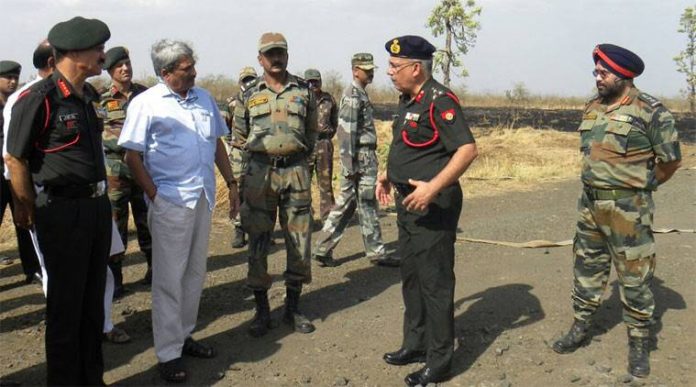This article is written by Gitika Jain pursuing BBA.LLB(Hons) from Amity University, Kolkata. This is an exhaustive article which deals with the relationship between media and military in India.
Table of Contents
Introduction
Operation Bajrang, 1990, Operation Woodrose, 1984, Operation Blue Star, 1984, Operation Black Tornado, 2008 and Operation Dhang, 2016; the common thing in these operations apart from the fact that they were anti-terrorist operations or anti-insurgency operations was that they have been a milestone in displaying poor information management that was the suppression of media to media mismanagement, lack of effective communication, and faltering effective communication. The tug of war between the media and the military is an ongoing thing which is the main hindrance in protecting national security.
To prove that the national security of a country is at risk can be taken from the 26/11 Mumbai attacks and January 2016 Pathankot airbase incident. The question of whether this love-hate relationship between the armed forces and news media in a democratic country can prevail is an important question. The reason for this ongoing war between the two is the nature and culture of both sides. The military side is of the opinion to share only the information which one needs to know while the media tries to expose to the public every kind of information whether relevant or irrelevant for the public to know.
Relations between Indian Armed Forces and Indian Private Conventional News Media
There are various social media platforms that are increasingly used today to communicate to the public at large, all kinds of information by the Indian private conventional news media such as Facebook, LinkedIn, Twitter, Instagram, and others. There are multiple factors based on which India’s military-news media relations continue to evolve. Out of these factors, one historical factor can be taken into consideration when the country was under British rule for 200 years. Back at the time of the British era, there used to be a distance between the rulers and the ruled. However, this is not a surprising fact that even after 70 years of Indian independence this policy is still continued in today’s world. The gradual development of technologies in the field of news media has led to an increasing gap between the two ends.
Media plays an impactful role in the minds of the people and influences them to change their thought process. However, if one tries to couple media and military, both can be termed to be linked to an arranged marriage where marriage is facilitated by the constitution of India. There is no doubt that the Indian Constitution comprises the importance of the role of news media in Article 19 which contains the provisions for freedom of speech and allows the journalist to speak what they wish for and consider it right. Being a partner within the executive branch of the central government, the military is responsible and accountable to the people at large because it uses public funds and utilizes it for its human resources. Both, the news media and military, are an integral part of a democratic country and cannot be compromised upon. The armed forces depend on the country’s media to build an image in the public.
Feeling of warmth between the two: Military and News media
After the Kargil war slowly and gradually the relationship between the news media and the military is feeling some warmth. The Indian armed forces are even assumed to be talking about media management as understandable, trustable, befriended, and possibly co-opted management to work with. In order to avoid any conflicts, it is important for the military to find new ways to cater to the public without managing the media. However, the media too should understand the responsibilities while covering up the news of the Indian army. It has become important to study the relationship between the two because of the following reasons:
- Redefining security.
- Amendments in the nature of warfare.
- Impact in military news media relations in the 4th generation warfare.
- The commitment of the citizens.
- The major influence of the news media.
Indian scenario
Over the past few years, many changes have occurred in the life of people-politics, lifestyle, economy, religion, and wars. Whenever a war occurs, the most important and impactful character of it is the support it receives from its state’s population. The huge mass of the public support, the war team receives, is a boon for them. Support of the public can be conveyed to the people in the war with the help of social media. Thus, one can assume that the media are the territory’s best friends and without them, the territories are nothing but the publicity is all. However, the media’s effects can also frustrate and desensitize the armed forces. Like everything has a boon and a bane attached to it so does the relationship between news media and military do. So powerful is the impact of news media that it can make the government alter their strategies because of the pressure it creates from the public on the government.
The Private News Media Industry in India
Indian news media is known for its wide coverage of news be it any subject; regional, national, international, economic, or political. However cold is the war between the two, and however disturbing the flame of the candle might be due to the wind, it will never extinguish. The news media industry from the very beginning has faced many ups and downs and has been a controversial topic throughout many years but it still remains an important and integral part of Indian society and will always be. There are various mediums of media like print, television, radio, internet, etc. The regulatory body of media is the Minister Of Information And Broadcasting (MIB) which deals with the content, distribution, and everything related to media. Indian government constituted the broadcasting corporation of India; Prasar Bharati, to fulfil the commitment of electronic media under its direct control.
Other bodies that deal with the news media are the Press Council of India (PCI) which was constituted in 1966 that helped the newspaper to maintain independence and the proper code of conduct. The Present Information Bureau (PIB) which was set up to pass the information to print and electronic media on various policies, the registrar of newspaper for India and that was established in 1956 and was recommended by the first press commission in 1953 and an amendment was added to this in the Press and Registration of Books Act, 1867.
Relationship between media and military
The two essential pillars of the democracy and sovereignty of India are the military and the news media. The relationship between the two, however, has not been an easy one and have faced many ups and downs. Armed forces always believe in secrecy and isolation from the public whereas the news media always believed in revealing all the facts and exposing everything to the public. From the time of the first world war, both of them are seeking a mutual ground to peacefully coexist in a democratic country and move forward with the help of each other. The focus of today’s armed forces and media relations is to improve public relations. For peace, there is a feeling of warmth between them and they are ready to move hand in hand in order to gain support from the public.
Factors responsible for the relationship between the two
In human society, over the past few years, there have been a variety of changes in the structure of the economy. Societies have become more transparent and open. The Right to Information Act is being taken by the people seriously. Such transparency in India will help to boost public confidence in news media as well as armed forces. It is important to gain support from the citizens of the country in order to create a positive environment in democracy and move forward without any hurdles. The greatest factor that has influenced the relationship between the two is the nature of the wars fought. No one is unaware of the situation when the news media and armed forces club together during the time of the war to gain public support at large. It is important for the Indian armed forces to propagate it about its activity to the citizens in general and enlighten them about the happenings during important events. The following factors affect the relationship between the two:
- The operational issue for the news media- The topics of anti-terrorism and counter-insurgency ought to bring violations of human rights. The nature of such conflicts is negative in itself. When these topics are covered in the media and the public raises questions on them the armed forces do not respond to such issues and remain shut. This affects the relationship between news media and military groups. Other topics of discussion can be 3rd-degree torture, extra-judicial killing, abductions, unlawful detention mass rape of local women, curtailment of freedom of assembling speech and movement, etc.
- The threat to life- The most difficult challenge a journalist faces on everyday bases are such unconventional topics that are a direct threat to his or her life while covering certain topics of issues. Many incidents have taken place in India, for example, the Khalistan movement in Punjab where the journalist was forced to accept the dictates of the military and convey the same in their media. Many other cases have been found in Kashmir in the northeast.
- Conflict in interest- The conflicting interests between news media and the military have been known by many since the past years. The news media on one hand is always interested in covering everything and exposing it to the public while on the other hand, the military tries to hide as many things as possible from the public and reveal only those things which they find genuine for the public to know. One such example could be the terrorist operation at the Taj in Mumbai on 26 November 2008 where the media was hungry for covering up news whereas the military was trying to hide as many things as possible.
- Issue of accessibility- Accessibility is an important factor that comes into play when the media wants to cover as much information as possible related to military operations. Some information cannot be collected because of the lack of accessibility to the areas where military operations take place. The military believes in the principle that the more isolated the area the less the coverage and a classic example of this can be the North-East region.
- Efficiency issue- Technology was the main hindrance to the news media a couple of years ago. During the 1991 Gulf war and Kargil war, the news media started developing technologically and started bringing into the living room the situation that happened during the wars, be it in a Jungle desert or any icy slopes.
- Maintaining balance- The biggest challenge that is faced by military and news media organisations is maintaining a balance between them. Humans are excited to know about each and every situation deeply and thoroughly in and around the world. This is where journalists come into play.
- Tons of coverage-The language used to display news through media and the pitch made by them to the public at large makes a huge difference in today’s world. They tend to frame the attitudes of the public on the acts of terrorists.
- The financial issue in covering news- The challenge faced by many journalists is the hindrance of finance. The news media industry is known as a profit-making industry and for that, it does whatever it takes to earn big fat money. This behaviour on their part creates a conflict between military groups and news media teams.
Conclusion
The relationship of which the Indian armed forces and the Indian private news media share is a delicate relationship and is based on various factors. As already read, Operation Bajrang, 1990, Operation Woodrose, 1984, Operation Blue Star, 1984, Operation Black Tornado, 2008 and Operation Dhang, 2016 are all the examples of displaying poor information management that was the suppression of media to media mismanagement, lack of effective communication, and faltering effective communication. The objective of studying the relationship between the two is to find out the mutual balance between them. There is no doubt that both of the entities have proven themselves from time to time and have never failed in any of the expectations of the public but due to the differences of opinion and being of different nature, they tend to have some conflicts time and again. Thus it is important for them to settle down at a conclusion and mutually agree on the terms to work hand in hand and improve the overall relationship in the Indian scenario.
References
- https://shodhganga.inflibnet.ac.in/bitstream/10603/267120/5/3%20chapter%201.pdf
- https://www.idsa-india.org/an-aug-400.html
- https://shodhganga.inflibnet.ac.in/bitstream/10603/76820/14/14_findings%20conclusion%20and%20recommendations.pdf
- https://shodhganga.inflibnet.ac.in/bitstream/10603/267120/7/5%20chapter%203.pdf
- https://shodhganga.inflibnet.ac.in/bitstream/10603/267120/5/3%20chapter%201.pdf
- https://shodhganga.inflibnet.ac.in/jspui/bitstream/10603/267120/6/4%20chapter%202.pdf
- https://shodhganga.inflibnet.ac.in/bitstream/10603/267120/8/6%20chapter%204.pdf
- https://shodhganga.inflibnet.ac.in/bitstream/10603/267120/9/7%20chapter%205.pdf
- https://shodhganga.inflibnet.ac.in/jspui/bitstream/10603/267120/10/8%20chapter%206.pdf
LawSikho has created a telegram group for exchanging legal knowledge, referrals and various opportunities. You can click on this link and join:
 Serato DJ Crack 2025Serato DJ PRO Crack
Serato DJ Crack 2025Serato DJ PRO Crack











 Allow notifications
Allow notifications



